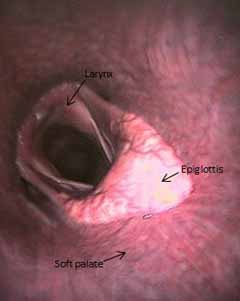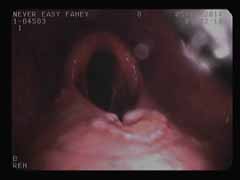The soft palate is an extension of the hard palate that separates the oral cavity and the nasal cavity. The soft palate forms a seal with the base of the epiglottis, which is a triangular shaped piece of cartilage that flips up to protect the airway during swallowing so that food does not enter the trachea and progress down into the lungs (Figure 1). During exercise the soft palate moves down and the airway opens up to maximize the amount of room for air to pass into the lungs. Importantly, the epiglottis sits firmly on top of the soft palate to form a seal between the oral and nasal cavities, allowing the horse to breathe entirely through its nose.
Dorsal displacement of the soft palate (DDSP) describes the condition where the soft palate displaces upwards to sit on top of the epiglottis (Figure 2). When this happens the soft palate ends up obstructing the opening to the trachea (larynx), and thereby reduces the amount of air that a horse can take in. DDSP most commonly occurs intermittently, especially during intense periods of exercise, and can be a cause of respiratory noise and poor performance. It is likely due to abnormal contraction of the muscles in the soft palate and throat, causing the soft palate to become flaccid and subsequently displace over the epiglottis. Less commonly, structural problems with the soft palate or epiglottis such as cysts, masses, or deformation of the epiglottic cartilage result in displacement of the soft palate even when the horse is at rest. Additionally, some neurological conditions or conditions that damage the nerves that control swallowing and airway function can also result in DDSP.


The most common signs of DDSP are a history of exercise intolerance and upper respiratory noise. The noise occurs during exhalation and is often described as a gurgling or vibrating noise. Some horses may also exhibit open mouth breathing when the soft palate is displaced as air is directed through the mouth during exhalation instead of through the nose. When the horse swallows, the soft palate and epiglottis relationship usually returns to normal and the horse can then proceed without difficulty and the respiratory noise goes away.
Intermittent displacement of the soft palate is most common, although in some rare cases a more permanent form of displacement can occur. In these cases horses often will cough.
The diagnosis of permanent dorsal displacement of the soft palate is easily made by standing endoscopic examination of the upper airway. The appearance as seen above is typical with the epiglottis lying on top of the soft palate. The more common intermittent displacement of the soft palate is often suspected based on the history of the horse making a characteristic gurgling sound during exercise combined with a history of the horse stopping during a race. Confirmation of this condition is best made with the use of overground endoscopy in which an endoscope is placed up the nostril to view the respiratory tract as the horse is exercised on their own or alongside another horse. Even then this condition can be difficult to replicate as the pressures of the racing environment are often hard to recreate on a standard exercising gallop. If the soft palate displaces during exercise and is not immediately replaced then a diagnosis of dorsal displacement of the soft palate can be made and steps aimed towards treatment can begin.
It should be noted that at rest, many horses will displace their soft palate. This is normal unless they are having difficulty in replacing it. In addition, a sedated horse will displace their soft palate and it can remain displaced for some time – this is not confirmation of a pathological problem.
Fitness is the first aspect that is addressed with this condition prior to any further intervention. The use of a figure-8 noseband to keep the horse from opening their mouth and bits such as the spoon or the Z bit are aimed at preventing the horse from playing with their tongue during exercise and thereby pushing the soft palate up into a displaced position. Any evidence of pharyngeal or upper respiratory tract inflammation on endoscopic examination should be treated with appropriate topical and oral anti-inflammatory agents.
Surgical Procedures
There are many different surgical procedures that have been used to try and correct DDSP. They are principally designed to try and either ‘stiffen’ up the flabby soft palate or epiglottis or recreate the seal between the epiglottis and soft palate and the surgeon involved may have a particular preference for what surgical procedures they prefer.
- ‘Stiffening’ of the soft palate (palatoplasty) has been traditionally performed by cauterising the oral or nasal sides of the soft palate. This has been achieved with the use of either cauterisation irons (oral surface performed under general anesthesia) or a laser (nasal surface under standing sedation) that is passed through the endoscopy channel and applied to the surface of the soft palate in multiple sites particularly concentrating on the free border at the level of the epiglottis. This creates scar tissue within the mucosa thereby potentially creating a less pliable tissue that is harder to displace. This has a reported success rate of 60%.
- Epiglottic augmentation in which a Teflon paste is injected into the tissue around and beneath the epiglottis to stiffen it has a reported success of 66% in which the cause of DDSP has been attributed to a hypoplastic epiglottis.
- Laryngeal advancement (Tie Forward) procedure is now the most widely accepted surgical treatment for confirmed DDSP. This involves permanently fixing the larynx forward by means of two sutures placed either side of the larynx tied to the more rostrally positioned basihyoid bone. The distance between the epiglottis and the opening of the larynx is reduced thereby making it harder for the soft palate to displace on top of the epiglottis. Procedures that help to increase the seal between the soft palate and epiglottis have orientated around either advancing the larynx forward, thereby pulling the epiglottis closer to the edge of the soft palate or preventing the caudal pull of the larynx by transection of two muscle groups (sternothyroid and sternohyoid that attach to the thyroid cartilage at the back of the larynx. Some surgeons like to combine this procedure with a staphylectomy in which a small portion of the free border of the soft palate is surgically removed. This can also be done as a separate procedure by transendoscopic laser.
Following surgery horses are typically maintained on antibiotics and anti-inflammatories for a short period of time combined with a short period of rest varying between 2 and 4 weeks depending on the procedure. Often the training aids discussed above are included in post-operative management in training and racing.
This condition can be frustrating to correct and may recur even after an initial period of success. This underlines the difficulty in knowing an exact cause in the majority of horses that are affected. After a thorough examination of the upper airway under various conditions, your veterinarian will be able to recommend the treatment option most likely to have the best impact on your horse.













